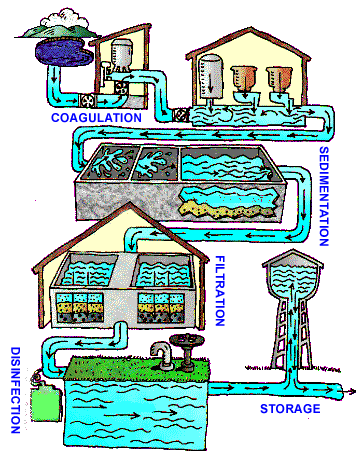Some Of Residential Water Treatment System
Table of ContentsEverything about Residential Water Treatment SystemThe Residential Water Treatment System PDFsExcitement About Residential Water Treatment SystemThe 7-Minute Rule for Residential Water Treatment System
1 The demand for large-scale water therapy, Water treatment is the process of getting rid of all those substances, whether organic, chemical or physical, that are potentially dangerous in water supply for human and domestic usage. Water likewise needs to be non-corrosive, suggesting it will not trigger damages to pipework.This develops a need for huge volumes of risk-free water to be provided reliably and continually, and this demand is growing. As city populaces raise, there is a need to discover brand-new resources to meet the growing need. If groundwater is available this can commonly be made use of with minimal treatment however any type of surface area water resource will certainly need to be treated to make it safe.
6 discusses just how this estimation is made but first you will take a look at the main stages in the water treatment procedure. 5. 2 Phases in large water therapy, There are commonly 7 actions (Figure 5. 2) in large water treatment for city municipal water (Abayneh, 2004). Each of the actions will certainly be defined subsequently in this area.

Residential Water Treatment System Things To Know Before You Buy
Right here the water is carefully mixed by paddles in a flocculation basin (Number 5. 5) and the flocs enter into call with each various other to form larger flocs. The flocculation basin frequently has a number of areas with lowering blending rates as the water advancements via the container (Number 5.
6(b)) for several hours for sedimentation to happen. The material gathered at the bottom of the tank is called sludge; this is eliminated for disposal. 5.2. 5 Purification, Purification is the procedure where solids are divided from a fluid. In water therapy, the solids that are not divided out in the sedimentation container are gotten rid of by passing the water via beds of sand and also gravel.
7), with a circulation rate of 48 cubic metres per square metre of filter surface per hour (this is written as 48 m3 m2 h1) are commonly utilized. When the filters have lots of caught solids, they are backwashed. In this procedure, tidy water as well as air are pumped backwards up the filter to remove the caught contaminations, and also the water lugging the dust (referred to as backwash) is pumped into the sewage system, if there is one.
6 Chlorination, After sedimentation, the water is disinfected to remove any kind of staying pathogenic micro-organisms. The most commonly made use of disinfectant (the chemical used for sanitation) is chlorine, in the type of a fluid (such as salt hypochlorite, Na, OCl) or a gas.
The Definitive Guide for Residential Water Treatment System
The quantity of chlorine left hereafter is called residual chlorine. This remains in the water all the way with the circulation system, securing it from any kind of micro-organisms that might enter it, up until the water gets to the customers. World Wellness Organization Guidelines (THAT, 2003) recommend an optimum residual chlorine of 5 mg l1 of water.

7 Additional treatment, Auxiliary therapy might occasionally be required for the benefit of the population. One such circumstances is the fluoridation of water, where fluoride is added to water. It has been stated by the Globe Wellness Company that 'fluoridation of water materials, where possible, is one of the most effective public wellness procedure for the prevention of oral degeneration' (WHO, 2001).

The Single Strategy To Use For Residential Water Treatment System
What does excess fluoride in the water lead to? The easiest way of doing this is to mix the high-fluoride water with water that has no (or really little) fluoride so that the final mixture is risk-free.
The two chemicals are added to as well as rapidly blended with the fluoride-contaminated water and also after that the water is stirred delicately. 5.3 Management of wastes you could try this out from water therapy plants, From the water therapy procedure that you have just examined, make a list of the various wastes that develop.
In the latter it is included in the inbound sewage, where it can assist settlement of solids. The backwash from the sand filter is discharged right into the drain or returned to the river after negotiation of solids. Packaging waste such as chemical drums can be returned to the vendor for reuse.
5.4 Sustainability and also durability in water therapy, In Research study Session 4 you read regarding some factors that can affect the sustainability of a water source. Minimizing soil erosion by growing trees and maintaining plant life can decrease the quantity of silt that builds up in a storage tank and extend its life. residential water treatment system.